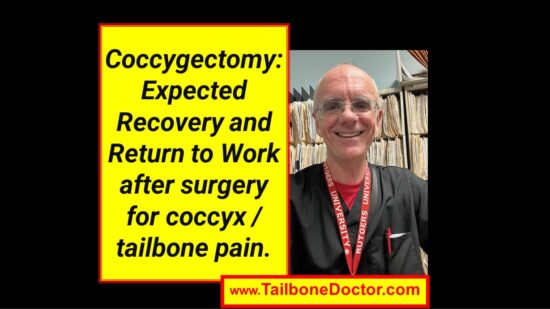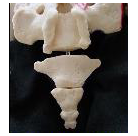(See the video below if you prefer to watch this as a video.)
Let’s talk about what to expect for recovery after coccyx removal surgery which is called coccygectomy.
I’m Dr. Foye, the director of the Coccyx Pain Center or Tailbone Pain Center here in the United States at Rutgers New Jersey Medical School and I’ve been treating patients with coccyx pain for about 25 years, thousands of patients.
The good news is that the vast majority of patients do not require surgical amputation for treatment of tailbone pain.
Most people do respond well to non-surgical treatment.
However, there is a small percentage of patients who may require surgery.
And for those patients who do require surgery (or that I send for a surgical consult) they always ask what should I expect after surgery? what’s the recovery like?
So let’s just talk a couple of minutes about that.
It really varies of course from patient to patient.
And that’s dependent on a couple of important factors.
Number one is the skin and how well it heals at the surgical site.
For some patients the skin heals nicely smoothly without any difficulty.
Other patients unfortunately run into problems with skin breakdown at the surgical site, where it may get infected or the skin just may not heal well. or the scar may open up partly because it’s an area that we sit on.
So there’s a lot of restrictions in terms of how many weeks or months until you can sit on the tailbone area after you’ve had the coccyx or tailbone surgically amputated or removed.
Another issue then is the pain at the area.
Some patients are able to tolerate sitting earlier than others.
So for some people it’s hey I’m only a couple of weeks out from surgery and I can already tolerate sitting for short periods of time, such as 10 or 15 minutes.
For other patients it may be months and months out and they’re still having a lot of pain or discomfort while sitting. This can be either because of scar tissue or because of a retained bone fragment or just the skin not healing well or those kinds of things.
So again, it runs the spectrum in terms of outcomes.
Other factors are things like what kind of job is the person trying to get back to.
So for example some jobs require sitting a lot of the time, without a lot of ability to get up and stand during the work day.
So if you think about a job like an airline pilot or a bus driver where once they sit in that chair they need to be sitting in the chair for the bulk of the time that they’re doing their job.
They’re not able to just stand up at will throughout the workday like people in other occupations might be able to.
Another factor is how long is the commute to work.
If we’re talking about return to work expectations, if somebody is working from home and they’re able to do to stand up while they do a video meeting or something like that, then obviously the chances of them getting back to work soon is much better than for somebody who has an hour and a half drive for their commute each way and thus they may have a really difficult time tolerating the drive to and from work, let alone the sitting that they may need to do when they’re actually at work.
In general, it’s going to be important for you to work closely with the surgeon and their surgical office or team.
I’m not a surgeon, so I most I spend most of my time and professional career helping people avoid going for surgery when they can.
But if you do go for surgery, it’s important to work with your surgical team.
Make sure it’s clear to them if you’re having any difficulties or challenges.
Ask them what their specific advice is for how soon you should be able to sit, how long you should be able to sit, when you should be able to go back to work, and those kinds of things.
The biggest advice I could give you is to make sure that number one of course work with your surgeon.
But number two that you go gradually.
The biggest mistake I see people make is that they’re happy that they finally had the tailbone removed (if they’re getting a good initial outcome) but then they either go back to work too soon or they start doing prolonged sitting.
Or they think well the tailbone is gone maybe I can sit on an exercise bike and try it for 20 minutes.
And really my concern there is that it’s very easy to overdo it and have a big setback.
I would rather see people go more gradually and have a nice smooth recovery where they can sit for longer and longer periods of time.
So hopefully this video is helpful just for helping you to have some general expectations for things to take into consideration if you are having tailbone removal surgery (coccygectomy).
Now you have some idea about the variability and the factors that go into what recovery time frame is like and how long until you can sit again (we’re talking usually 6 weeks 8 weeks and then it’s going to be even a gradual progression after that).
And for return to work again that’s going to be very depending on the job and the commute and those kinds of things.
And coccygectomy is really known as a surgery that has a much longer recovery time than most surgeries.
So, it’s not the type of thing where hey I had this the tailbone removed that was yesterday today I’m totally fine and going about my full life’s activities.
That would be naive to go in thinking that’s going to be the outcome.
So hopefully this gives you some context for that.
Some people say it takes 6 to 12 months before fully assessing response to coccygectomy.
If you want more information you can find me online at www.TailboneDoctor.com you can grab a copy of my book on Amazon.
I hope this is helpful for you.
Here is the video: https://www.youtube.com/watch?v=hVpYnwr2kdI
Here is the link to the video: https://youtu.be/hVpYnwr2kdI
COME FOR RELIEF: For more information on coccyx pain, or to be evaluated in-person by Dr. Foye’s Coccyx Pain Center in the United States, go to: www.TailboneDoctor.com
– Patrick Foye, M.D., Director of the Tailbone Pain Center, New Jersey, United States.
Below, is the screen-capture image from the video:

- Coccygectomy: Expected Recovery and Return to Work after surgery for coccyx pain, tailbone pain. - November 28, 2023
- PRP Platelet Rich Plasma or Prolotherapy for Tailbone Pain, Coccyx Pain - October 25, 2023
- Reasons for Normal X-rays and MRI Despite Tailbone Pain, Coccyx Pain - October 3, 2023

